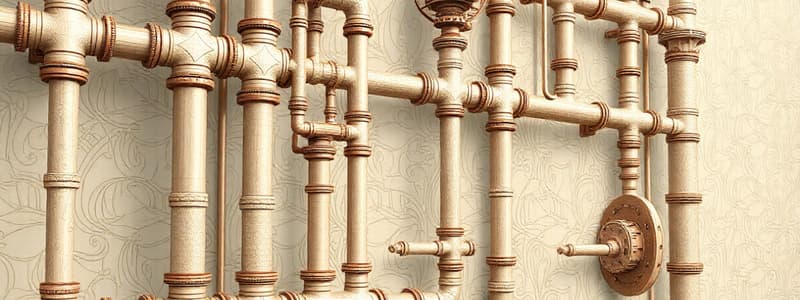Podcast
Questions and Answers
What does NPS stand for in the context of pipe sizing?
What does NPS stand for in the context of pipe sizing?
- Normal Pressure Size
- Net Pipe Specification
- National Pipe Standard
- Nominal Pipe Size (correct)
What does a higher schedule number indicate about the pipe?
What does a higher schedule number indicate about the pipe?
- It has a larger inside diameter
- It is less pressure resistant
- It has a smaller outside diameter
- It has a thicker wall (correct)
How do you determine the DN equivalent for sizes larger than NPS 80?
How do you determine the DN equivalent for sizes larger than NPS 80?
- Multiply the NPS size designation by 25 (correct)
- Multiply the NPS size designation by 15
- Multiply the NPS size designation by 50
- Subtract 25 from the NPS size designation
What does a schedule number followed by the letter S represent?
What does a schedule number followed by the letter S represent?
In terms of wall thickness, what is true for NPS 10 and smaller schedule 40 pipes?
In terms of wall thickness, what is true for NPS 10 and smaller schedule 40 pipes?
Which class has a PN designator of 150?
Which class has a PN designator of 150?
What is primarily used to classify pipes in the industry?
What is primarily used to classify pipes in the industry?
What does the schedule number indicate in the formula $1000 P/S$?
What does the schedule number indicate in the formula $1000 P/S$?
What is the horizontal position groove weld characterized by?
What is the horizontal position groove weld characterized by?
What is the main purpose of packing pipe with sand during hot bending?
What is the main purpose of packing pipe with sand during hot bending?
Which process in welding involves the branch piping connections while the main pipeline is operational?
Which process in welding involves the branch piping connections while the main pipeline is operational?
What does the hydraulic radius measure in fluid mechanics?
What does the hydraulic radius measure in fluid mechanics?
What does an impact test determine about materials?
What does an impact test determine about materials?
What is incomplete fusion in welding?
What is incomplete fusion in welding?
What is the main purpose of induction heating in welding?
What is the main purpose of induction heating in welding?
What does inspection in piping welding involve?
What does inspection in piping welding involve?
What is the main purpose of an expansion joint in piping systems?
What is the main purpose of an expansion joint in piping systems?
Which process is primarily involved in the fabrication of piping components?
Which process is primarily involved in the fabrication of piping components?
What characterizes erosion in piping systems?
What characterizes erosion in piping systems?
Which statement accurately defines 'examination' in the context of piping systems?
Which statement accurately defines 'examination' in the context of piping systems?
What is the purpose of extruded nozzles in piping?
What is the purpose of extruded nozzles in piping?
What does a 'fillet weld' refer to?
What does a 'fillet weld' refer to?
Which factor primarily influences the erosion process in piping?
Which factor primarily influences the erosion process in piping?
What does 'face of weld' refer to in welding terminology?
What does 'face of weld' refer to in welding terminology?
Flashcards are hidden until you start studying
Study Notes
Piping Handbook - 7th Edition
- Edited by Mohinder L. Nayyar, P.E., ASME Fellow.
- Previous editions edited by Reno C. King and Sabin Crocker.
- Published by McGraw-Hill.
- Copyright 2000, 1992, 1967, with earlier copyrights dating back to 1930.
- ISBN 0-07-047106-1.
Chapter Content Overview
- Part A: Piping Components and Fundamentals: Includes chapters on piping materials, codes and standards, manufacturing, fabrication, installation, bolted joints, various piping systems (prestressed concrete, grooved and pressfit), and valve selection. Specific authors are listed for each chapter.
- Part B: Generic Design Considerations: Covers design documents, bases, layout, stress analysis, support systems, heat tracing, thermal insulation, fluid flow, and various types of piping linings (cement-mortar, concrete, epoxy, rubber, plastic). Specific authors are listed for each chapter.
Key Definitions and Concepts (from excerpts shown)
- Piping Classification: Typically aligned with pressure-temperature ratings from ASME B16.5, corresponding to PN designators (Table A1.2 provides a class/PN comparison).
- Pipe Size Designation: Uses Nominal Pipe Size (NPS) and Diameter Nominal (DN) designations. DN 50 is equivalent to NPS 2; for sizes above NPS 80, multiply NPS by 25 to obtain DN.
- Pipe Wall Thickness: Defined by schedule numbers (5, 10, 20, etc.), indicating the approximate value of 1000P/S (P=service pressure, S=allowable stress in psi). Higher schedule numbers mean thicker pipes. Original designations (STD, XS, XXS) retained but correspond to specific schedule numbers depending on pipe size. Schedule numbers followed by "S" are per ASME B36.19M (primarily for stainless steel).
- ASME Standards: ASME B36.19M and ASME B36.10M are referenced for pipe dimensions and schedules; B36.19M may not cover all sizes.
- Additional Key Terms: Definitions provided for terms such as erection, erosion, examination, expansion joint, extruded nozzles/pipe, fabrication, face of weld, filler metal, fillet weld, fire hazard, flat-land bevel, horizontal-position groove weld, horizontal rolled position, hot bending, hot taps, hot working, hydraulic radius, impact test, imperfection, incomplete fusion, indication, induction heating, inspection, and instrument piping. Many of these definitions include clarifying figures (referenced but not shown in provided text).
Studying That Suits You
Use AI to generate personalized quizzes and flashcards to suit your learning preferences.




